BENVGGP4: Unilever's Use of Crowdsourcing for Problem Solving
VerifiedAdded on 2023/06/09
|11
|3001
|252
Essay
AI Summary
This essay examines collective problem-solving techniques, focusing on crowdsourcing, and applies it to a case study of Unilever. Unilever, a British-Dutch transnational consumer goods company, utilizes crowdsourcing through initiatives like The Unilever Foundry to address challenges and foster innovation. The essay discusses the strengths and weaknesses of crowdsourcing, highlighting its cost-effectiveness and potential for diverse perspectives while acknowledging concerns about confidentiality and communication barriers. It suggests applying crowdsourcing to internal problems like customer service and packaging issues. The analysis includes alternative problem-solving methods like Participatory Action Research. The essay concludes by emphasizing the importance of considering both the advantages and disadvantages of crowdsourcing before implementation to ensure effective problem resolution and community engagement.
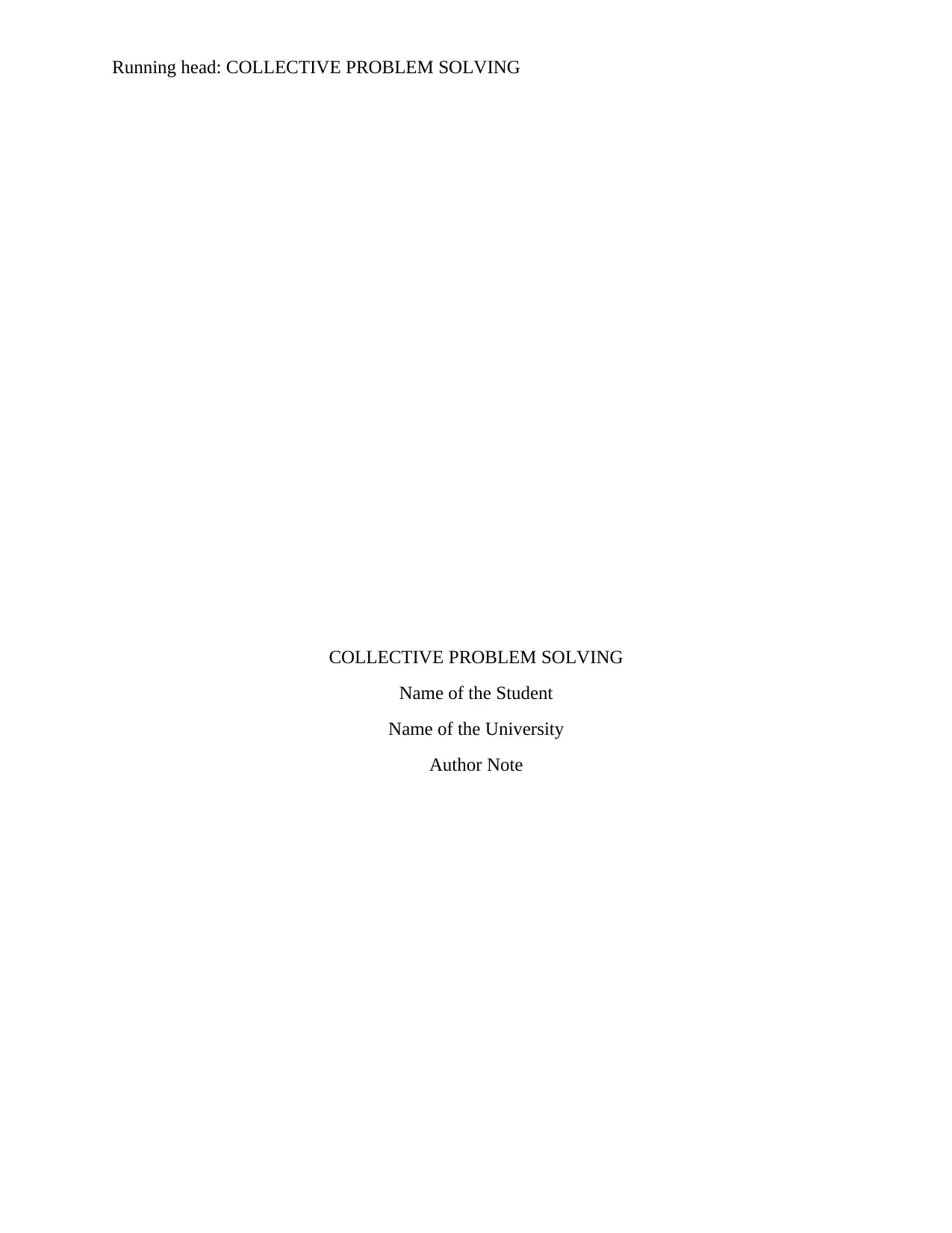
Running head: COLLECTIVE PROBLEM SOLVING
COLLECTIVE PROBLEM SOLVING
Name of the Student
Name of the University
Author Note
COLLECTIVE PROBLEM SOLVING
Name of the Student
Name of the University
Author Note
Paraphrase This Document
Need a fresh take? Get an instant paraphrase of this document with our AI Paraphraser
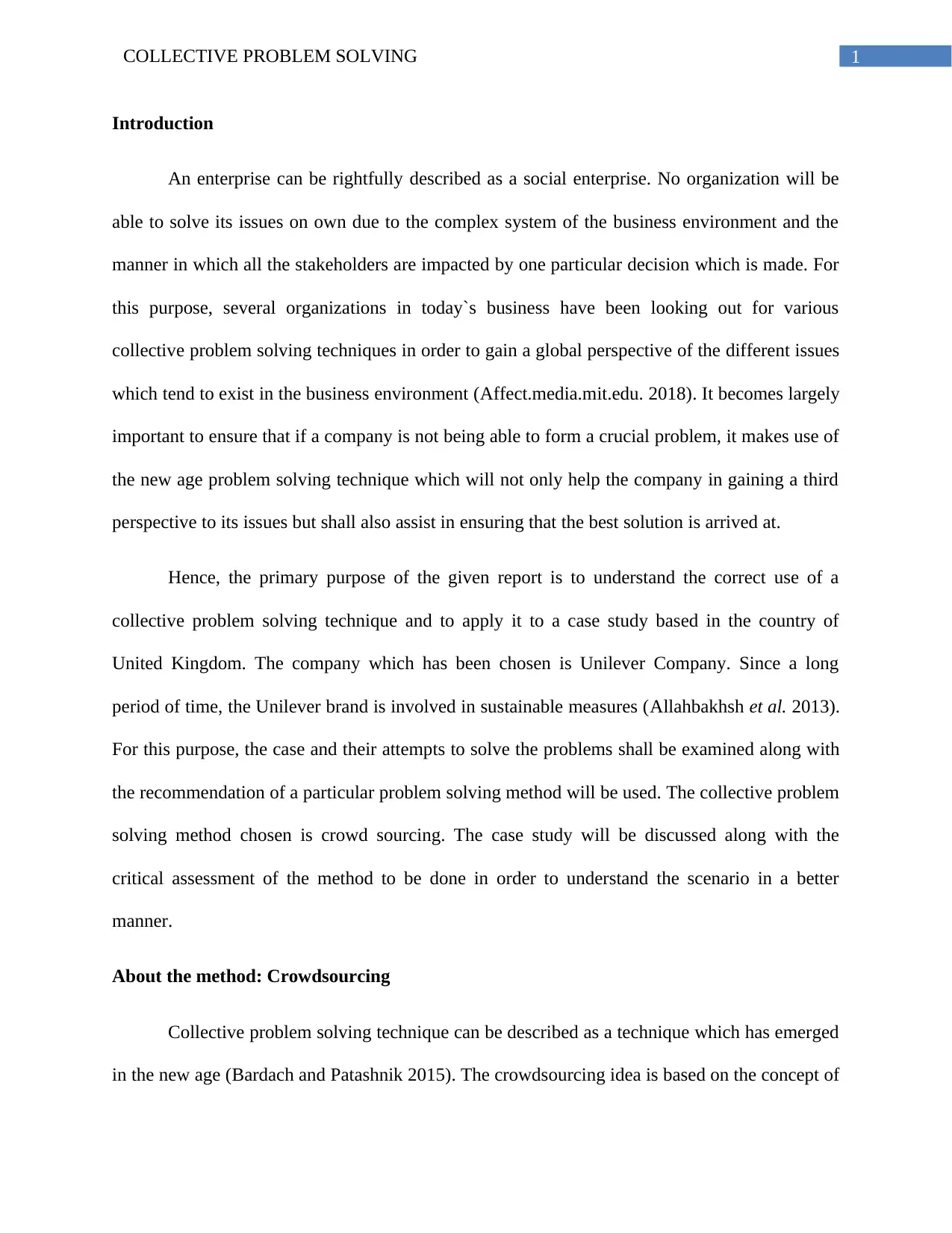
1COLLECTIVE PROBLEM SOLVING
Introduction
An enterprise can be rightfully described as a social enterprise. No organization will be
able to solve its issues on own due to the complex system of the business environment and the
manner in which all the stakeholders are impacted by one particular decision which is made. For
this purpose, several organizations in today`s business have been looking out for various
collective problem solving techniques in order to gain a global perspective of the different issues
which tend to exist in the business environment (Affect.media.mit.edu. 2018). It becomes largely
important to ensure that if a company is not being able to form a crucial problem, it makes use of
the new age problem solving technique which will not only help the company in gaining a third
perspective to its issues but shall also assist in ensuring that the best solution is arrived at.
Hence, the primary purpose of the given report is to understand the correct use of a
collective problem solving technique and to apply it to a case study based in the country of
United Kingdom. The company which has been chosen is Unilever Company. Since a long
period of time, the Unilever brand is involved in sustainable measures (Allahbakhsh et al. 2013).
For this purpose, the case and their attempts to solve the problems shall be examined along with
the recommendation of a particular problem solving method will be used. The collective problem
solving method chosen is crowd sourcing. The case study will be discussed along with the
critical assessment of the method to be done in order to understand the scenario in a better
manner.
About the method: Crowdsourcing
Collective problem solving technique can be described as a technique which has emerged
in the new age (Bardach and Patashnik 2015). The crowdsourcing idea is based on the concept of
Introduction
An enterprise can be rightfully described as a social enterprise. No organization will be
able to solve its issues on own due to the complex system of the business environment and the
manner in which all the stakeholders are impacted by one particular decision which is made. For
this purpose, several organizations in today`s business have been looking out for various
collective problem solving techniques in order to gain a global perspective of the different issues
which tend to exist in the business environment (Affect.media.mit.edu. 2018). It becomes largely
important to ensure that if a company is not being able to form a crucial problem, it makes use of
the new age problem solving technique which will not only help the company in gaining a third
perspective to its issues but shall also assist in ensuring that the best solution is arrived at.
Hence, the primary purpose of the given report is to understand the correct use of a
collective problem solving technique and to apply it to a case study based in the country of
United Kingdom. The company which has been chosen is Unilever Company. Since a long
period of time, the Unilever brand is involved in sustainable measures (Allahbakhsh et al. 2013).
For this purpose, the case and their attempts to solve the problems shall be examined along with
the recommendation of a particular problem solving method will be used. The collective problem
solving method chosen is crowd sourcing. The case study will be discussed along with the
critical assessment of the method to be done in order to understand the scenario in a better
manner.
About the method: Crowdsourcing
Collective problem solving technique can be described as a technique which has emerged
in the new age (Bardach and Patashnik 2015). The crowdsourcing idea is based on the concept of
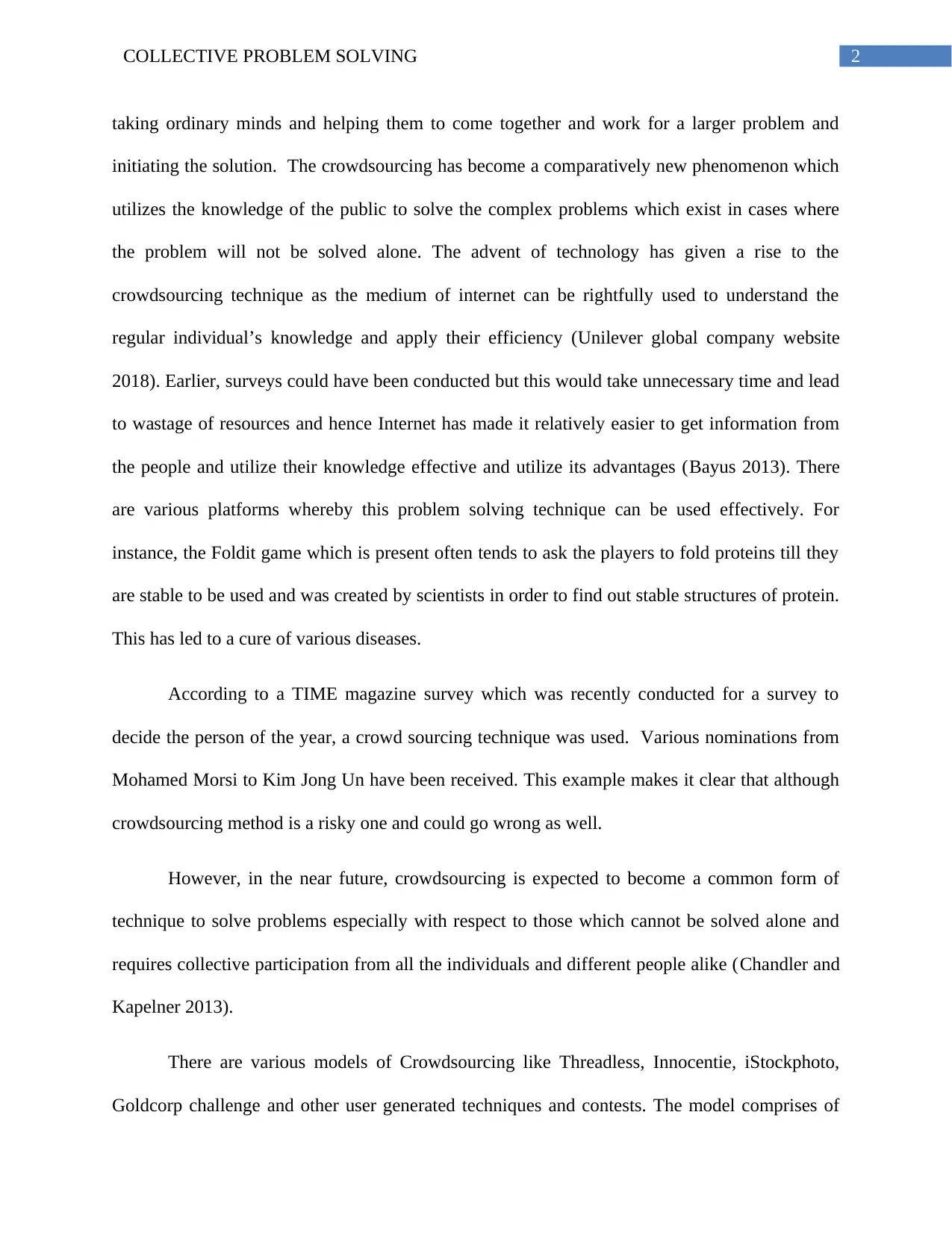
2COLLECTIVE PROBLEM SOLVING
taking ordinary minds and helping them to come together and work for a larger problem and
initiating the solution. The crowdsourcing has become a comparatively new phenomenon which
utilizes the knowledge of the public to solve the complex problems which exist in cases where
the problem will not be solved alone. The advent of technology has given a rise to the
crowdsourcing technique as the medium of internet can be rightfully used to understand the
regular individual’s knowledge and apply their efficiency (Unilever global company website
2018). Earlier, surveys could have been conducted but this would take unnecessary time and lead
to wastage of resources and hence Internet has made it relatively easier to get information from
the people and utilize their knowledge effective and utilize its advantages (Bayus 2013). There
are various platforms whereby this problem solving technique can be used effectively. For
instance, the Foldit game which is present often tends to ask the players to fold proteins till they
are stable to be used and was created by scientists in order to find out stable structures of protein.
This has led to a cure of various diseases.
According to a TIME magazine survey which was recently conducted for a survey to
decide the person of the year, a crowd sourcing technique was used. Various nominations from
Mohamed Morsi to Kim Jong Un have been received. This example makes it clear that although
crowdsourcing method is a risky one and could go wrong as well.
However, in the near future, crowdsourcing is expected to become a common form of
technique to solve problems especially with respect to those which cannot be solved alone and
requires collective participation from all the individuals and different people alike (Chandler and
Kapelner 2013).
There are various models of Crowdsourcing like Threadless, Innocentie, iStockphoto,
Goldcorp challenge and other user generated techniques and contests. The model comprises of
taking ordinary minds and helping them to come together and work for a larger problem and
initiating the solution. The crowdsourcing has become a comparatively new phenomenon which
utilizes the knowledge of the public to solve the complex problems which exist in cases where
the problem will not be solved alone. The advent of technology has given a rise to the
crowdsourcing technique as the medium of internet can be rightfully used to understand the
regular individual’s knowledge and apply their efficiency (Unilever global company website
2018). Earlier, surveys could have been conducted but this would take unnecessary time and lead
to wastage of resources and hence Internet has made it relatively easier to get information from
the people and utilize their knowledge effective and utilize its advantages (Bayus 2013). There
are various platforms whereby this problem solving technique can be used effectively. For
instance, the Foldit game which is present often tends to ask the players to fold proteins till they
are stable to be used and was created by scientists in order to find out stable structures of protein.
This has led to a cure of various diseases.
According to a TIME magazine survey which was recently conducted for a survey to
decide the person of the year, a crowd sourcing technique was used. Various nominations from
Mohamed Morsi to Kim Jong Un have been received. This example makes it clear that although
crowdsourcing method is a risky one and could go wrong as well.
However, in the near future, crowdsourcing is expected to become a common form of
technique to solve problems especially with respect to those which cannot be solved alone and
requires collective participation from all the individuals and different people alike (Chandler and
Kapelner 2013).
There are various models of Crowdsourcing like Threadless, Innocentie, iStockphoto,
Goldcorp challenge and other user generated techniques and contests. The model comprises of
⊘ This is a preview!⊘
Do you want full access?
Subscribe today to unlock all pages.

Trusted by 1+ million students worldwide
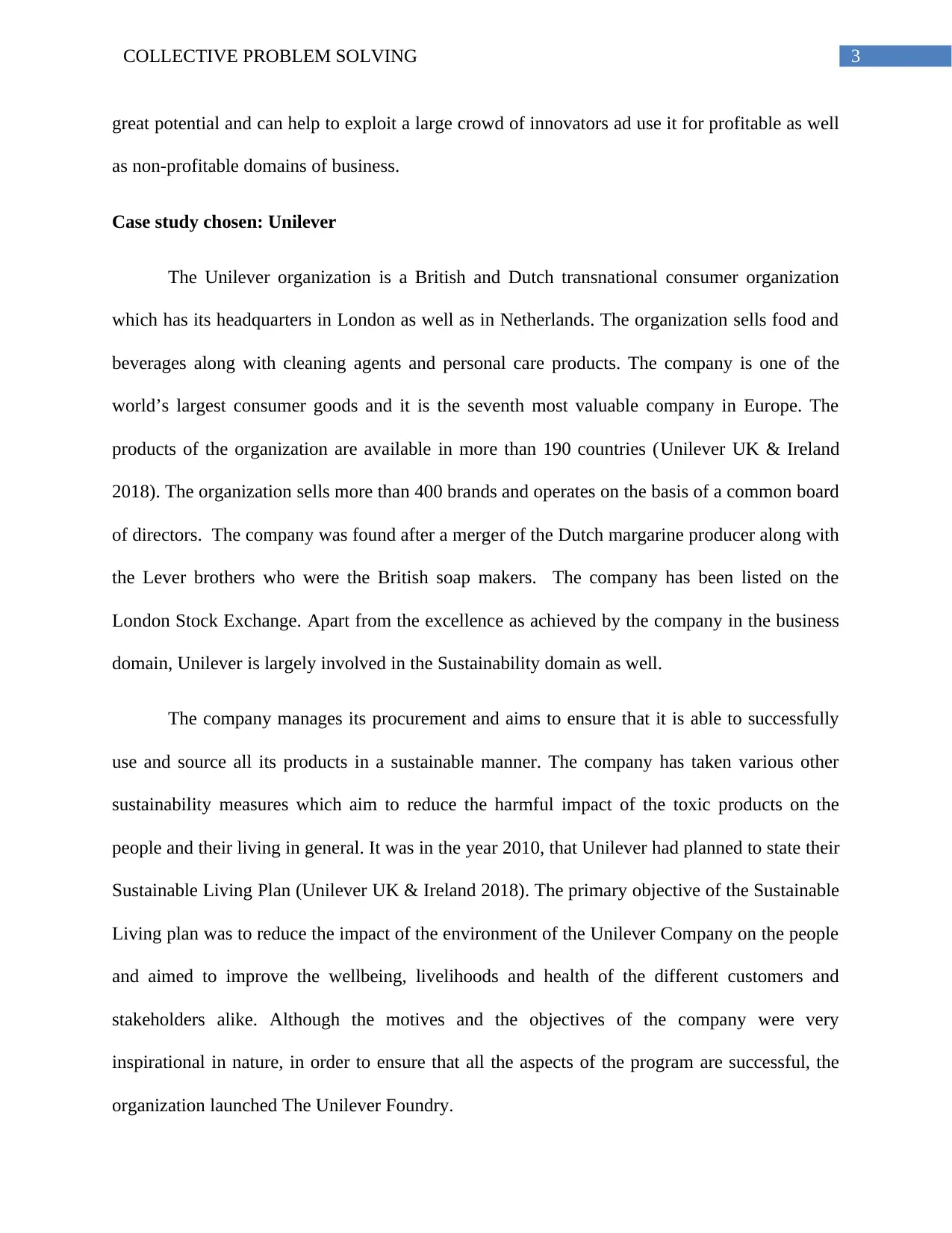
3COLLECTIVE PROBLEM SOLVING
great potential and can help to exploit a large crowd of innovators ad use it for profitable as well
as non-profitable domains of business.
Case study chosen: Unilever
The Unilever organization is a British and Dutch transnational consumer organization
which has its headquarters in London as well as in Netherlands. The organization sells food and
beverages along with cleaning agents and personal care products. The company is one of the
world’s largest consumer goods and it is the seventh most valuable company in Europe. The
products of the organization are available in more than 190 countries (Unilever UK & Ireland
2018). The organization sells more than 400 brands and operates on the basis of a common board
of directors. The company was found after a merger of the Dutch margarine producer along with
the Lever brothers who were the British soap makers. The company has been listed on the
London Stock Exchange. Apart from the excellence as achieved by the company in the business
domain, Unilever is largely involved in the Sustainability domain as well.
The company manages its procurement and aims to ensure that it is able to successfully
use and source all its products in a sustainable manner. The company has taken various other
sustainability measures which aim to reduce the harmful impact of the toxic products on the
people and their living in general. It was in the year 2010, that Unilever had planned to state their
Sustainable Living Plan (Unilever UK & Ireland 2018). The primary objective of the Sustainable
Living plan was to reduce the impact of the environment of the Unilever Company on the people
and aimed to improve the wellbeing, livelihoods and health of the different customers and
stakeholders alike. Although the motives and the objectives of the company were very
inspirational in nature, in order to ensure that all the aspects of the program are successful, the
organization launched The Unilever Foundry.
great potential and can help to exploit a large crowd of innovators ad use it for profitable as well
as non-profitable domains of business.
Case study chosen: Unilever
The Unilever organization is a British and Dutch transnational consumer organization
which has its headquarters in London as well as in Netherlands. The organization sells food and
beverages along with cleaning agents and personal care products. The company is one of the
world’s largest consumer goods and it is the seventh most valuable company in Europe. The
products of the organization are available in more than 190 countries (Unilever UK & Ireland
2018). The organization sells more than 400 brands and operates on the basis of a common board
of directors. The company was found after a merger of the Dutch margarine producer along with
the Lever brothers who were the British soap makers. The company has been listed on the
London Stock Exchange. Apart from the excellence as achieved by the company in the business
domain, Unilever is largely involved in the Sustainability domain as well.
The company manages its procurement and aims to ensure that it is able to successfully
use and source all its products in a sustainable manner. The company has taken various other
sustainability measures which aim to reduce the harmful impact of the toxic products on the
people and their living in general. It was in the year 2010, that Unilever had planned to state their
Sustainable Living Plan (Unilever UK & Ireland 2018). The primary objective of the Sustainable
Living plan was to reduce the impact of the environment of the Unilever Company on the people
and aimed to improve the wellbeing, livelihoods and health of the different customers and
stakeholders alike. Although the motives and the objectives of the company were very
inspirational in nature, in order to ensure that all the aspects of the program are successful, the
organization launched The Unilever Foundry.
Paraphrase This Document
Need a fresh take? Get an instant paraphrase of this document with our AI Paraphraser
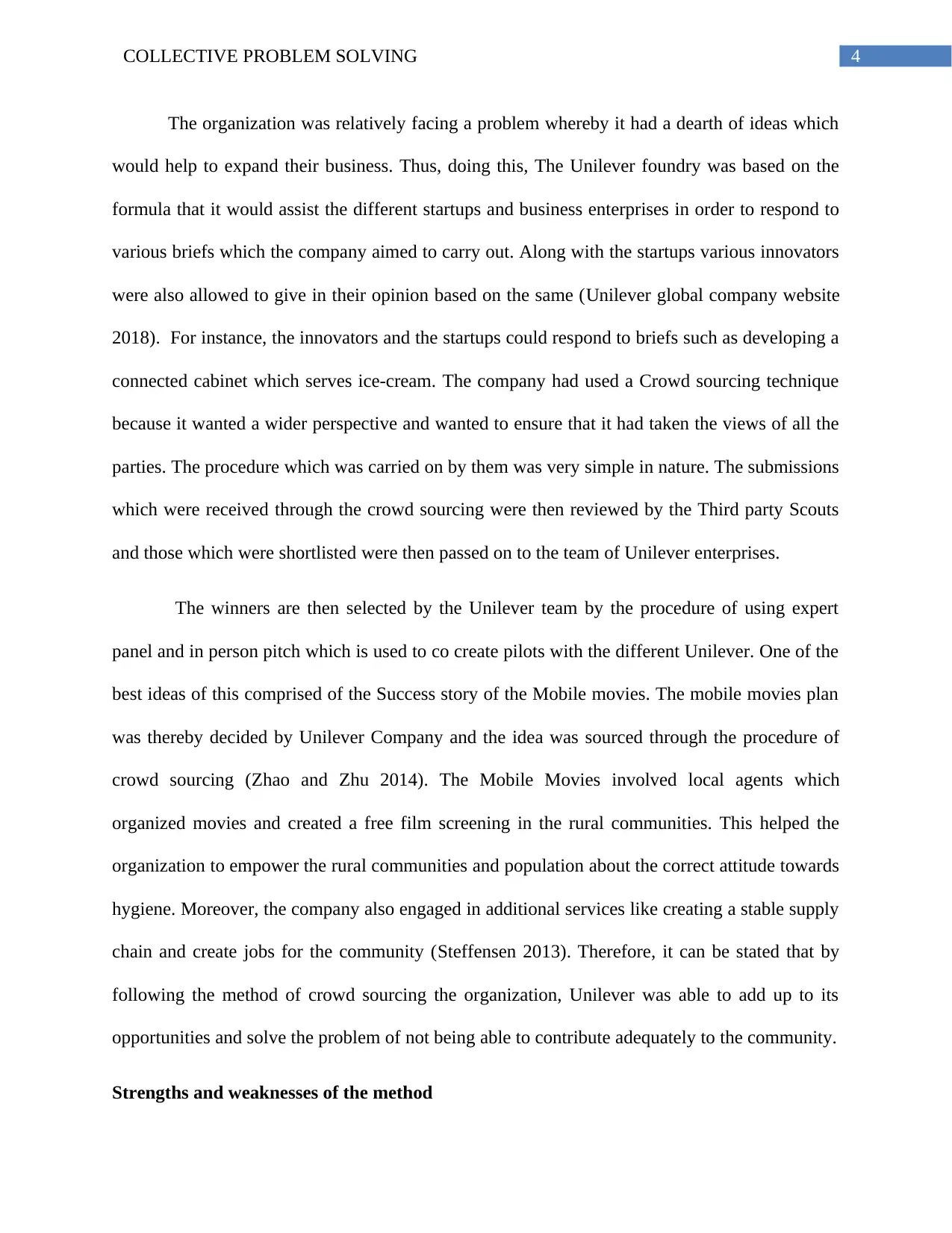
4COLLECTIVE PROBLEM SOLVING
The organization was relatively facing a problem whereby it had a dearth of ideas which
would help to expand their business. Thus, doing this, The Unilever foundry was based on the
formula that it would assist the different startups and business enterprises in order to respond to
various briefs which the company aimed to carry out. Along with the startups various innovators
were also allowed to give in their opinion based on the same (Unilever global company website
2018). For instance, the innovators and the startups could respond to briefs such as developing a
connected cabinet which serves ice-cream. The company had used a Crowd sourcing technique
because it wanted a wider perspective and wanted to ensure that it had taken the views of all the
parties. The procedure which was carried on by them was very simple in nature. The submissions
which were received through the crowd sourcing were then reviewed by the Third party Scouts
and those which were shortlisted were then passed on to the team of Unilever enterprises.
The winners are then selected by the Unilever team by the procedure of using expert
panel and in person pitch which is used to co create pilots with the different Unilever. One of the
best ideas of this comprised of the Success story of the Mobile movies. The mobile movies plan
was thereby decided by Unilever Company and the idea was sourced through the procedure of
crowd sourcing (Zhao and Zhu 2014). The Mobile Movies involved local agents which
organized movies and created a free film screening in the rural communities. This helped the
organization to empower the rural communities and population about the correct attitude towards
hygiene. Moreover, the company also engaged in additional services like creating a stable supply
chain and create jobs for the community (Steffensen 2013). Therefore, it can be stated that by
following the method of crowd sourcing the organization, Unilever was able to add up to its
opportunities and solve the problem of not being able to contribute adequately to the community.
Strengths and weaknesses of the method
The organization was relatively facing a problem whereby it had a dearth of ideas which
would help to expand their business. Thus, doing this, The Unilever foundry was based on the
formula that it would assist the different startups and business enterprises in order to respond to
various briefs which the company aimed to carry out. Along with the startups various innovators
were also allowed to give in their opinion based on the same (Unilever global company website
2018). For instance, the innovators and the startups could respond to briefs such as developing a
connected cabinet which serves ice-cream. The company had used a Crowd sourcing technique
because it wanted a wider perspective and wanted to ensure that it had taken the views of all the
parties. The procedure which was carried on by them was very simple in nature. The submissions
which were received through the crowd sourcing were then reviewed by the Third party Scouts
and those which were shortlisted were then passed on to the team of Unilever enterprises.
The winners are then selected by the Unilever team by the procedure of using expert
panel and in person pitch which is used to co create pilots with the different Unilever. One of the
best ideas of this comprised of the Success story of the Mobile movies. The mobile movies plan
was thereby decided by Unilever Company and the idea was sourced through the procedure of
crowd sourcing (Zhao and Zhu 2014). The Mobile Movies involved local agents which
organized movies and created a free film screening in the rural communities. This helped the
organization to empower the rural communities and population about the correct attitude towards
hygiene. Moreover, the company also engaged in additional services like creating a stable supply
chain and create jobs for the community (Steffensen 2013). Therefore, it can be stated that by
following the method of crowd sourcing the organization, Unilever was able to add up to its
opportunities and solve the problem of not being able to contribute adequately to the community.
Strengths and weaknesses of the method
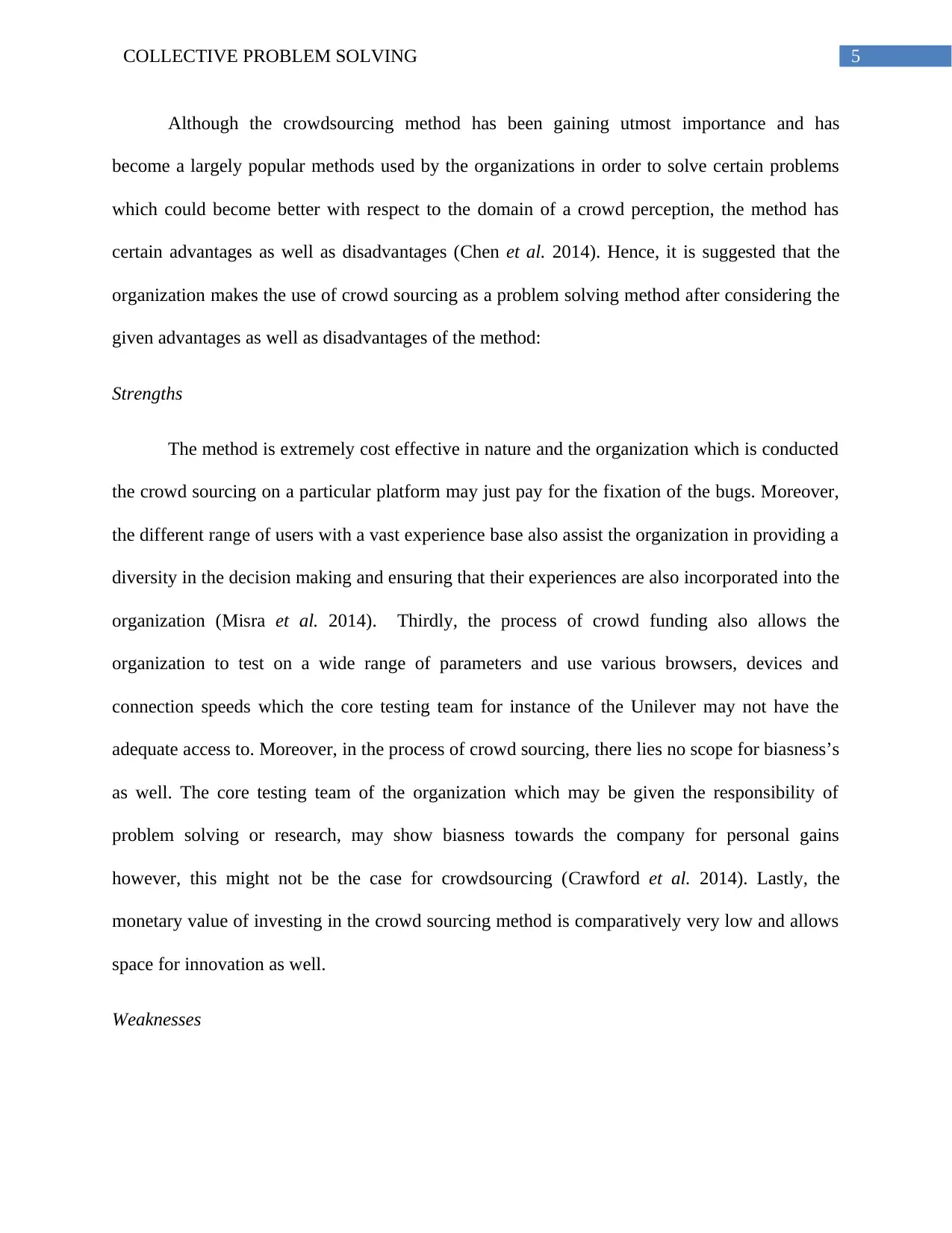
5COLLECTIVE PROBLEM SOLVING
Although the crowdsourcing method has been gaining utmost importance and has
become a largely popular methods used by the organizations in order to solve certain problems
which could become better with respect to the domain of a crowd perception, the method has
certain advantages as well as disadvantages (Chen et al. 2014). Hence, it is suggested that the
organization makes the use of crowd sourcing as a problem solving method after considering the
given advantages as well as disadvantages of the method:
Strengths
The method is extremely cost effective in nature and the organization which is conducted
the crowd sourcing on a particular platform may just pay for the fixation of the bugs. Moreover,
the different range of users with a vast experience base also assist the organization in providing a
diversity in the decision making and ensuring that their experiences are also incorporated into the
organization (Misra et al. 2014). Thirdly, the process of crowd funding also allows the
organization to test on a wide range of parameters and use various browsers, devices and
connection speeds which the core testing team for instance of the Unilever may not have the
adequate access to. Moreover, in the process of crowd sourcing, there lies no scope for biasness’s
as well. The core testing team of the organization which may be given the responsibility of
problem solving or research, may show biasness towards the company for personal gains
however, this might not be the case for crowdsourcing (Crawford et al. 2014). Lastly, the
monetary value of investing in the crowd sourcing method is comparatively very low and allows
space for innovation as well.
Weaknesses
Although the crowdsourcing method has been gaining utmost importance and has
become a largely popular methods used by the organizations in order to solve certain problems
which could become better with respect to the domain of a crowd perception, the method has
certain advantages as well as disadvantages (Chen et al. 2014). Hence, it is suggested that the
organization makes the use of crowd sourcing as a problem solving method after considering the
given advantages as well as disadvantages of the method:
Strengths
The method is extremely cost effective in nature and the organization which is conducted
the crowd sourcing on a particular platform may just pay for the fixation of the bugs. Moreover,
the different range of users with a vast experience base also assist the organization in providing a
diversity in the decision making and ensuring that their experiences are also incorporated into the
organization (Misra et al. 2014). Thirdly, the process of crowd funding also allows the
organization to test on a wide range of parameters and use various browsers, devices and
connection speeds which the core testing team for instance of the Unilever may not have the
adequate access to. Moreover, in the process of crowd sourcing, there lies no scope for biasness’s
as well. The core testing team of the organization which may be given the responsibility of
problem solving or research, may show biasness towards the company for personal gains
however, this might not be the case for crowdsourcing (Crawford et al. 2014). Lastly, the
monetary value of investing in the crowd sourcing method is comparatively very low and allows
space for innovation as well.
Weaknesses
⊘ This is a preview!⊘
Do you want full access?
Subscribe today to unlock all pages.

Trusted by 1+ million students worldwide
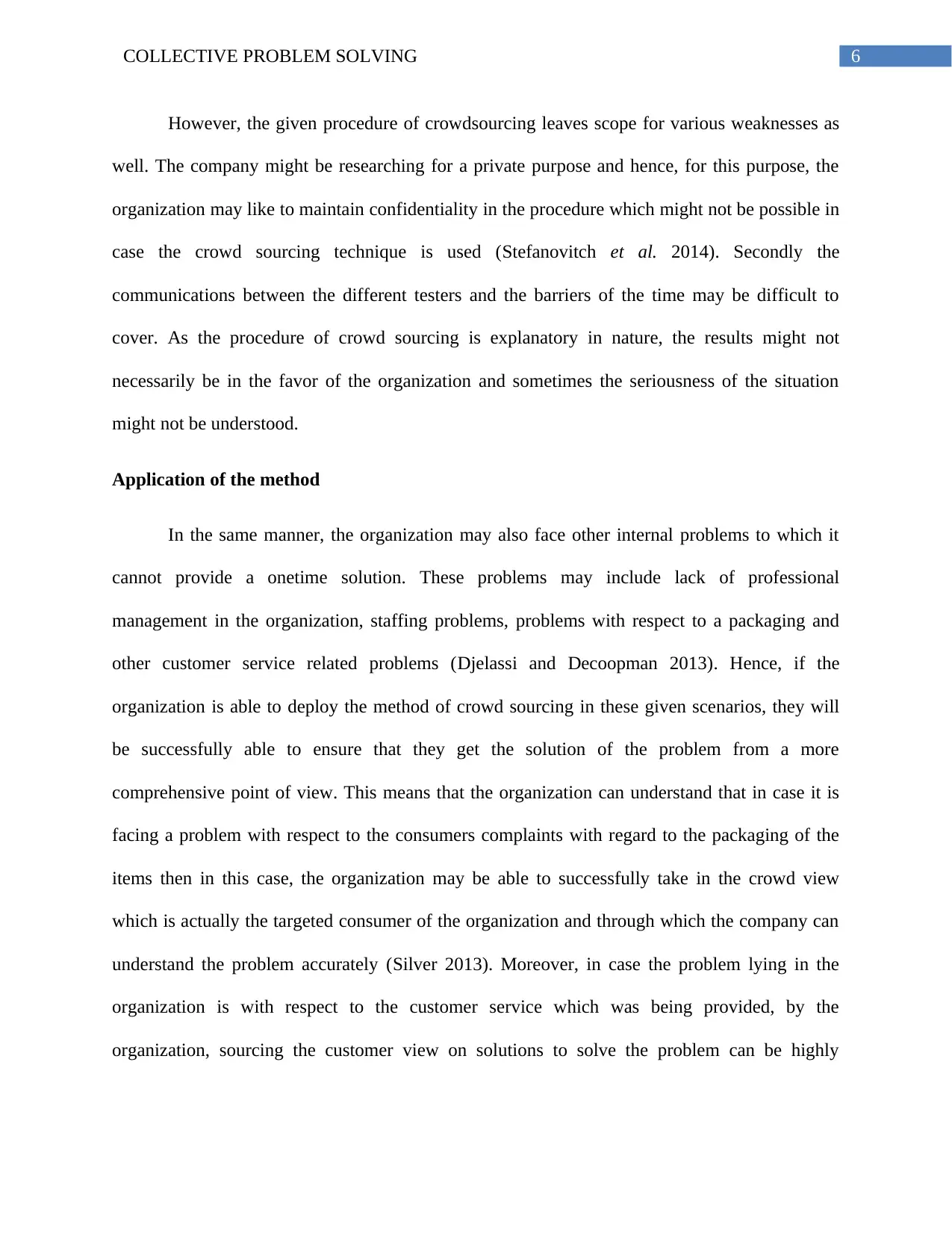
6COLLECTIVE PROBLEM SOLVING
However, the given procedure of crowdsourcing leaves scope for various weaknesses as
well. The company might be researching for a private purpose and hence, for this purpose, the
organization may like to maintain confidentiality in the procedure which might not be possible in
case the crowd sourcing technique is used (Stefanovitch et al. 2014). Secondly the
communications between the different testers and the barriers of the time may be difficult to
cover. As the procedure of crowd sourcing is explanatory in nature, the results might not
necessarily be in the favor of the organization and sometimes the seriousness of the situation
might not be understood.
Application of the method
In the same manner, the organization may also face other internal problems to which it
cannot provide a onetime solution. These problems may include lack of professional
management in the organization, staffing problems, problems with respect to a packaging and
other customer service related problems (Djelassi and Decoopman 2013). Hence, if the
organization is able to deploy the method of crowd sourcing in these given scenarios, they will
be successfully able to ensure that they get the solution of the problem from a more
comprehensive point of view. This means that the organization can understand that in case it is
facing a problem with respect to the consumers complaints with regard to the packaging of the
items then in this case, the organization may be able to successfully take in the crowd view
which is actually the targeted consumer of the organization and through which the company can
understand the problem accurately (Silver 2013). Moreover, in case the problem lying in the
organization is with respect to the customer service which was being provided, by the
organization, sourcing the customer view on solutions to solve the problem can be highly
However, the given procedure of crowdsourcing leaves scope for various weaknesses as
well. The company might be researching for a private purpose and hence, for this purpose, the
organization may like to maintain confidentiality in the procedure which might not be possible in
case the crowd sourcing technique is used (Stefanovitch et al. 2014). Secondly the
communications between the different testers and the barriers of the time may be difficult to
cover. As the procedure of crowd sourcing is explanatory in nature, the results might not
necessarily be in the favor of the organization and sometimes the seriousness of the situation
might not be understood.
Application of the method
In the same manner, the organization may also face other internal problems to which it
cannot provide a onetime solution. These problems may include lack of professional
management in the organization, staffing problems, problems with respect to a packaging and
other customer service related problems (Djelassi and Decoopman 2013). Hence, if the
organization is able to deploy the method of crowd sourcing in these given scenarios, they will
be successfully able to ensure that they get the solution of the problem from a more
comprehensive point of view. This means that the organization can understand that in case it is
facing a problem with respect to the consumers complaints with regard to the packaging of the
items then in this case, the organization may be able to successfully take in the crowd view
which is actually the targeted consumer of the organization and through which the company can
understand the problem accurately (Silver 2013). Moreover, in case the problem lying in the
organization is with respect to the customer service which was being provided, by the
organization, sourcing the customer view on solutions to solve the problem can be highly
Paraphrase This Document
Need a fresh take? Get an instant paraphrase of this document with our AI Paraphraser
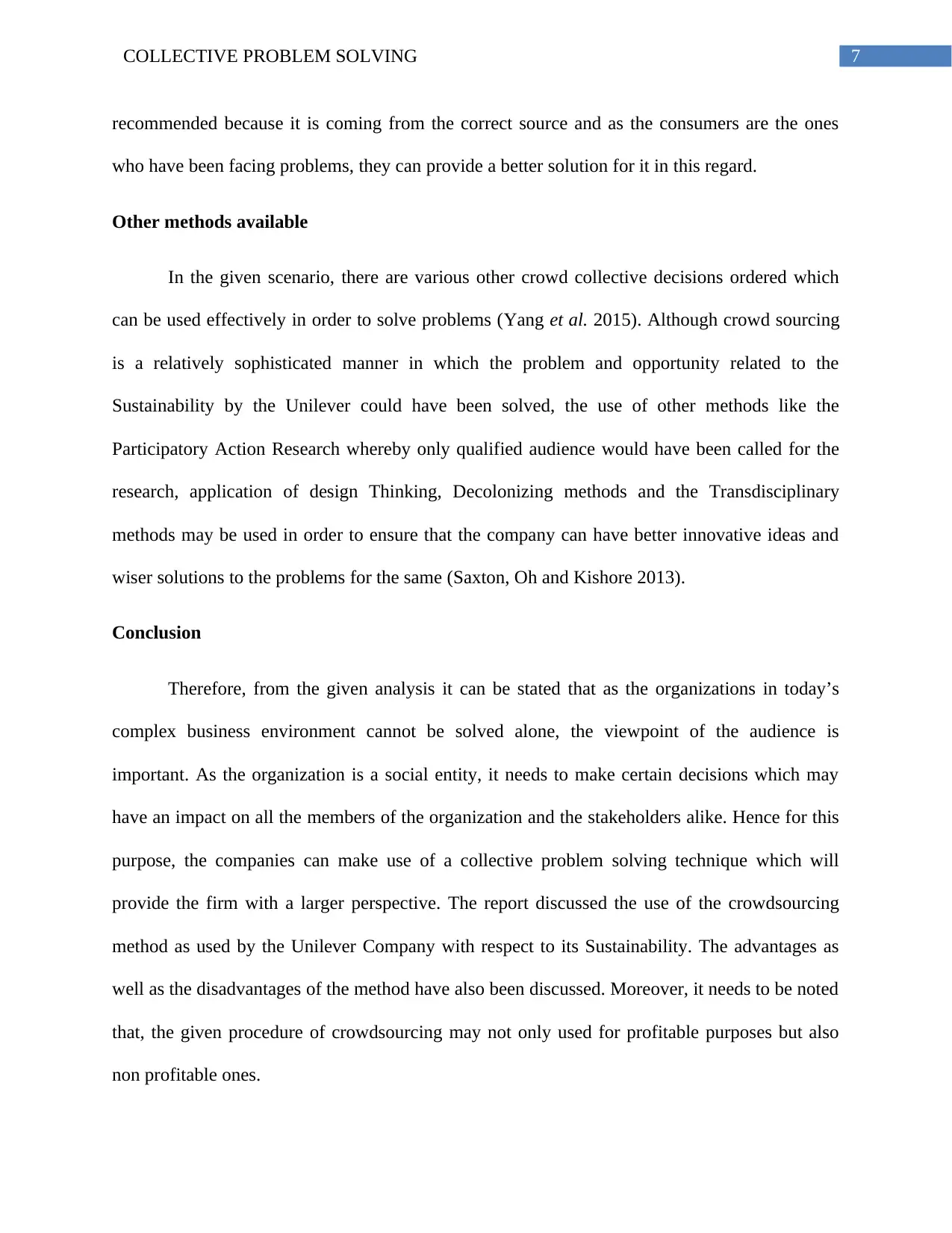
7COLLECTIVE PROBLEM SOLVING
recommended because it is coming from the correct source and as the consumers are the ones
who have been facing problems, they can provide a better solution for it in this regard.
Other methods available
In the given scenario, there are various other crowd collective decisions ordered which
can be used effectively in order to solve problems (Yang et al. 2015). Although crowd sourcing
is a relatively sophisticated manner in which the problem and opportunity related to the
Sustainability by the Unilever could have been solved, the use of other methods like the
Participatory Action Research whereby only qualified audience would have been called for the
research, application of design Thinking, Decolonizing methods and the Transdisciplinary
methods may be used in order to ensure that the company can have better innovative ideas and
wiser solutions to the problems for the same (Saxton, Oh and Kishore 2013).
Conclusion
Therefore, from the given analysis it can be stated that as the organizations in today’s
complex business environment cannot be solved alone, the viewpoint of the audience is
important. As the organization is a social entity, it needs to make certain decisions which may
have an impact on all the members of the organization and the stakeholders alike. Hence for this
purpose, the companies can make use of a collective problem solving technique which will
provide the firm with a larger perspective. The report discussed the use of the crowdsourcing
method as used by the Unilever Company with respect to its Sustainability. The advantages as
well as the disadvantages of the method have also been discussed. Moreover, it needs to be noted
that, the given procedure of crowdsourcing may not only used for profitable purposes but also
non profitable ones.
recommended because it is coming from the correct source and as the consumers are the ones
who have been facing problems, they can provide a better solution for it in this regard.
Other methods available
In the given scenario, there are various other crowd collective decisions ordered which
can be used effectively in order to solve problems (Yang et al. 2015). Although crowd sourcing
is a relatively sophisticated manner in which the problem and opportunity related to the
Sustainability by the Unilever could have been solved, the use of other methods like the
Participatory Action Research whereby only qualified audience would have been called for the
research, application of design Thinking, Decolonizing methods and the Transdisciplinary
methods may be used in order to ensure that the company can have better innovative ideas and
wiser solutions to the problems for the same (Saxton, Oh and Kishore 2013).
Conclusion
Therefore, from the given analysis it can be stated that as the organizations in today’s
complex business environment cannot be solved alone, the viewpoint of the audience is
important. As the organization is a social entity, it needs to make certain decisions which may
have an impact on all the members of the organization and the stakeholders alike. Hence for this
purpose, the companies can make use of a collective problem solving technique which will
provide the firm with a larger perspective. The report discussed the use of the crowdsourcing
method as used by the Unilever Company with respect to its Sustainability. The advantages as
well as the disadvantages of the method have also been discussed. Moreover, it needs to be noted
that, the given procedure of crowdsourcing may not only used for profitable purposes but also
non profitable ones.
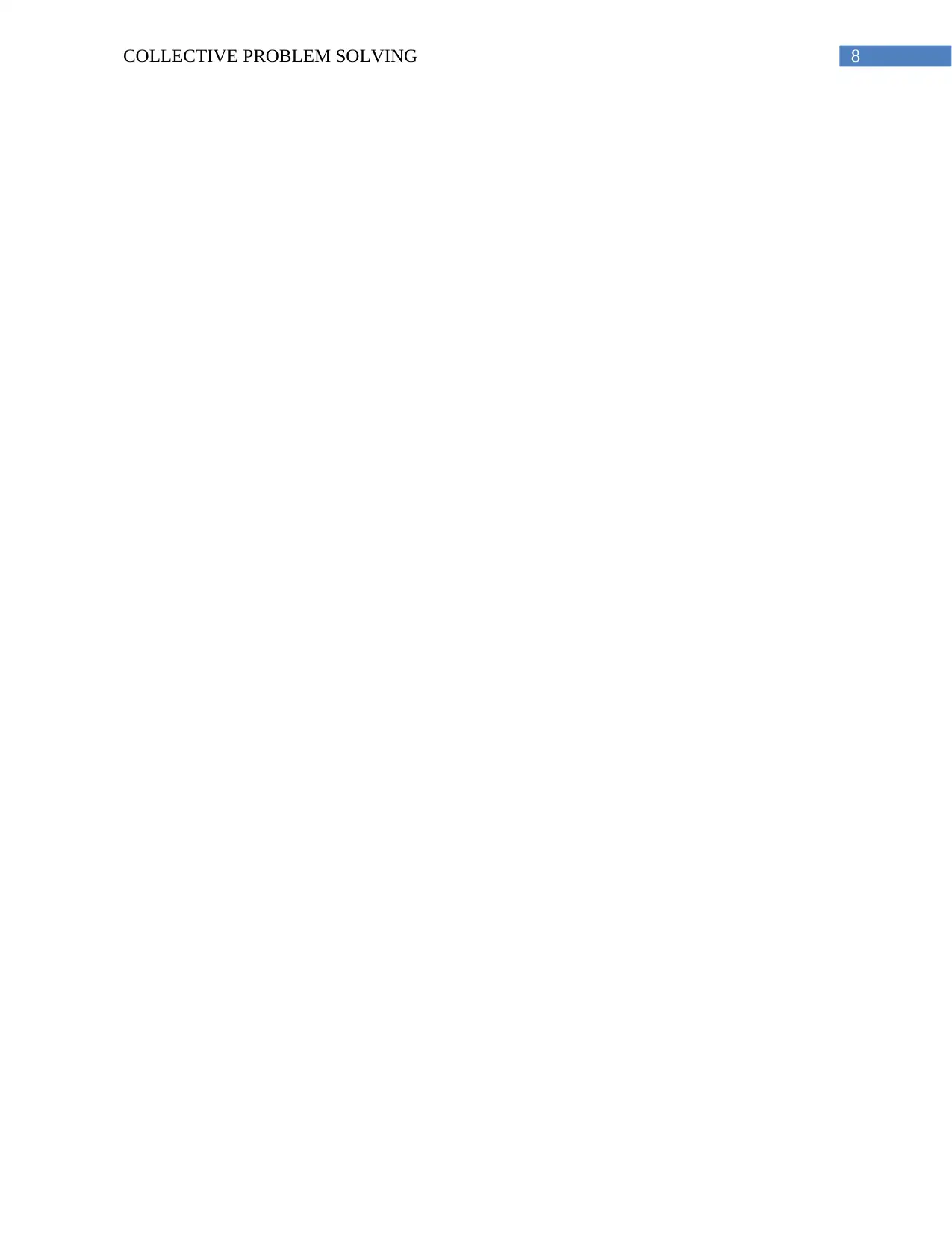
8COLLECTIVE PROBLEM SOLVING
⊘ This is a preview!⊘
Do you want full access?
Subscribe today to unlock all pages.

Trusted by 1+ million students worldwide
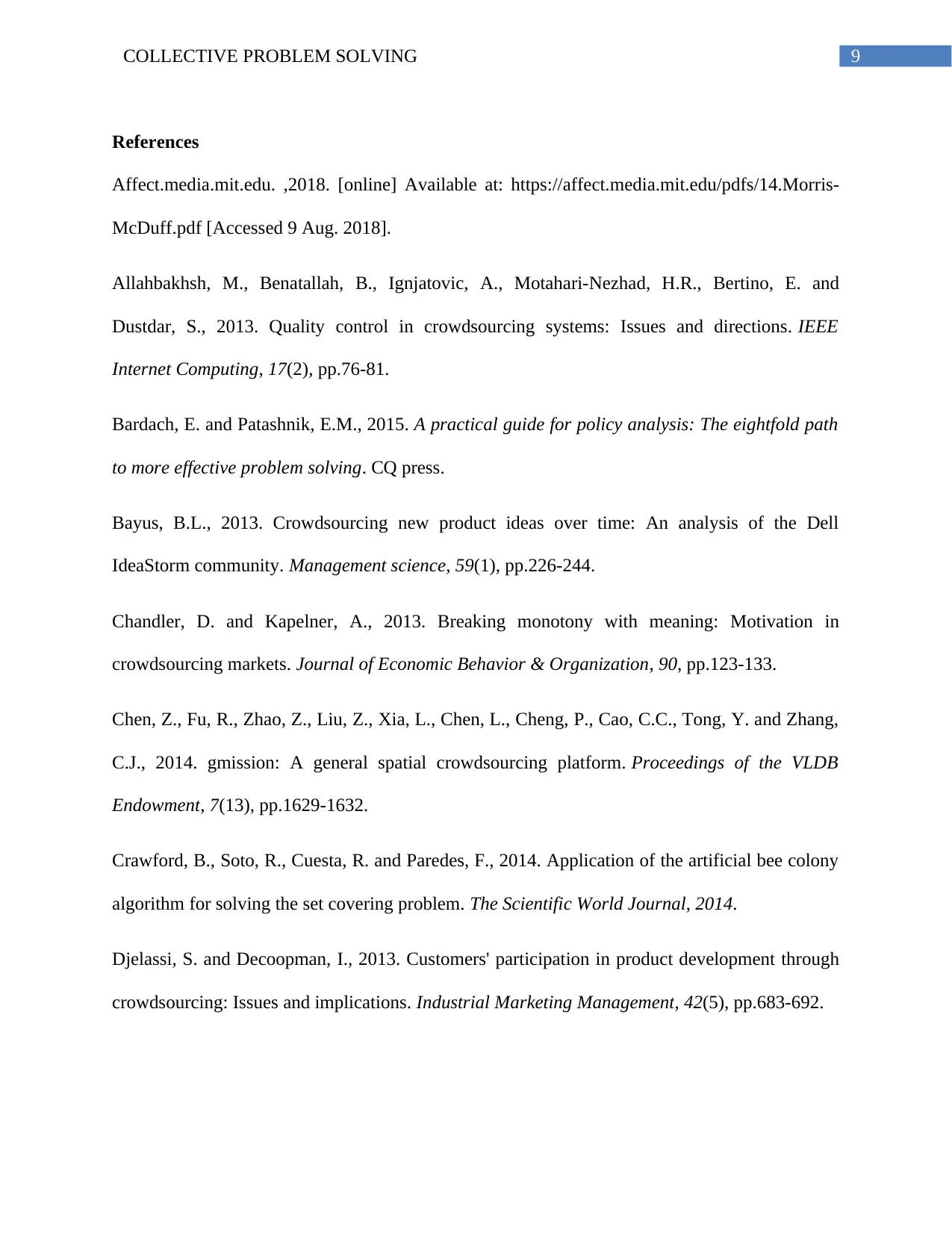
9COLLECTIVE PROBLEM SOLVING
References
Affect.media.mit.edu. ,2018. [online] Available at: https://affect.media.mit.edu/pdfs/14.Morris-
McDuff.pdf [Accessed 9 Aug. 2018].
Allahbakhsh, M., Benatallah, B., Ignjatovic, A., Motahari-Nezhad, H.R., Bertino, E. and
Dustdar, S., 2013. Quality control in crowdsourcing systems: Issues and directions. IEEE
Internet Computing, 17(2), pp.76-81.
Bardach, E. and Patashnik, E.M., 2015. A practical guide for policy analysis: The eightfold path
to more effective problem solving. CQ press.
Bayus, B.L., 2013. Crowdsourcing new product ideas over time: An analysis of the Dell
IdeaStorm community. Management science, 59(1), pp.226-244.
Chandler, D. and Kapelner, A., 2013. Breaking monotony with meaning: Motivation in
crowdsourcing markets. Journal of Economic Behavior & Organization, 90, pp.123-133.
Chen, Z., Fu, R., Zhao, Z., Liu, Z., Xia, L., Chen, L., Cheng, P., Cao, C.C., Tong, Y. and Zhang,
C.J., 2014. gmission: A general spatial crowdsourcing platform. Proceedings of the VLDB
Endowment, 7(13), pp.1629-1632.
Crawford, B., Soto, R., Cuesta, R. and Paredes, F., 2014. Application of the artificial bee colony
algorithm for solving the set covering problem. The Scientific World Journal, 2014.
Djelassi, S. and Decoopman, I., 2013. Customers' participation in product development through
crowdsourcing: Issues and implications. Industrial Marketing Management, 42(5), pp.683-692.
References
Affect.media.mit.edu. ,2018. [online] Available at: https://affect.media.mit.edu/pdfs/14.Morris-
McDuff.pdf [Accessed 9 Aug. 2018].
Allahbakhsh, M., Benatallah, B., Ignjatovic, A., Motahari-Nezhad, H.R., Bertino, E. and
Dustdar, S., 2013. Quality control in crowdsourcing systems: Issues and directions. IEEE
Internet Computing, 17(2), pp.76-81.
Bardach, E. and Patashnik, E.M., 2015. A practical guide for policy analysis: The eightfold path
to more effective problem solving. CQ press.
Bayus, B.L., 2013. Crowdsourcing new product ideas over time: An analysis of the Dell
IdeaStorm community. Management science, 59(1), pp.226-244.
Chandler, D. and Kapelner, A., 2013. Breaking monotony with meaning: Motivation in
crowdsourcing markets. Journal of Economic Behavior & Organization, 90, pp.123-133.
Chen, Z., Fu, R., Zhao, Z., Liu, Z., Xia, L., Chen, L., Cheng, P., Cao, C.C., Tong, Y. and Zhang,
C.J., 2014. gmission: A general spatial crowdsourcing platform. Proceedings of the VLDB
Endowment, 7(13), pp.1629-1632.
Crawford, B., Soto, R., Cuesta, R. and Paredes, F., 2014. Application of the artificial bee colony
algorithm for solving the set covering problem. The Scientific World Journal, 2014.
Djelassi, S. and Decoopman, I., 2013. Customers' participation in product development through
crowdsourcing: Issues and implications. Industrial Marketing Management, 42(5), pp.683-692.
Paraphrase This Document
Need a fresh take? Get an instant paraphrase of this document with our AI Paraphraser
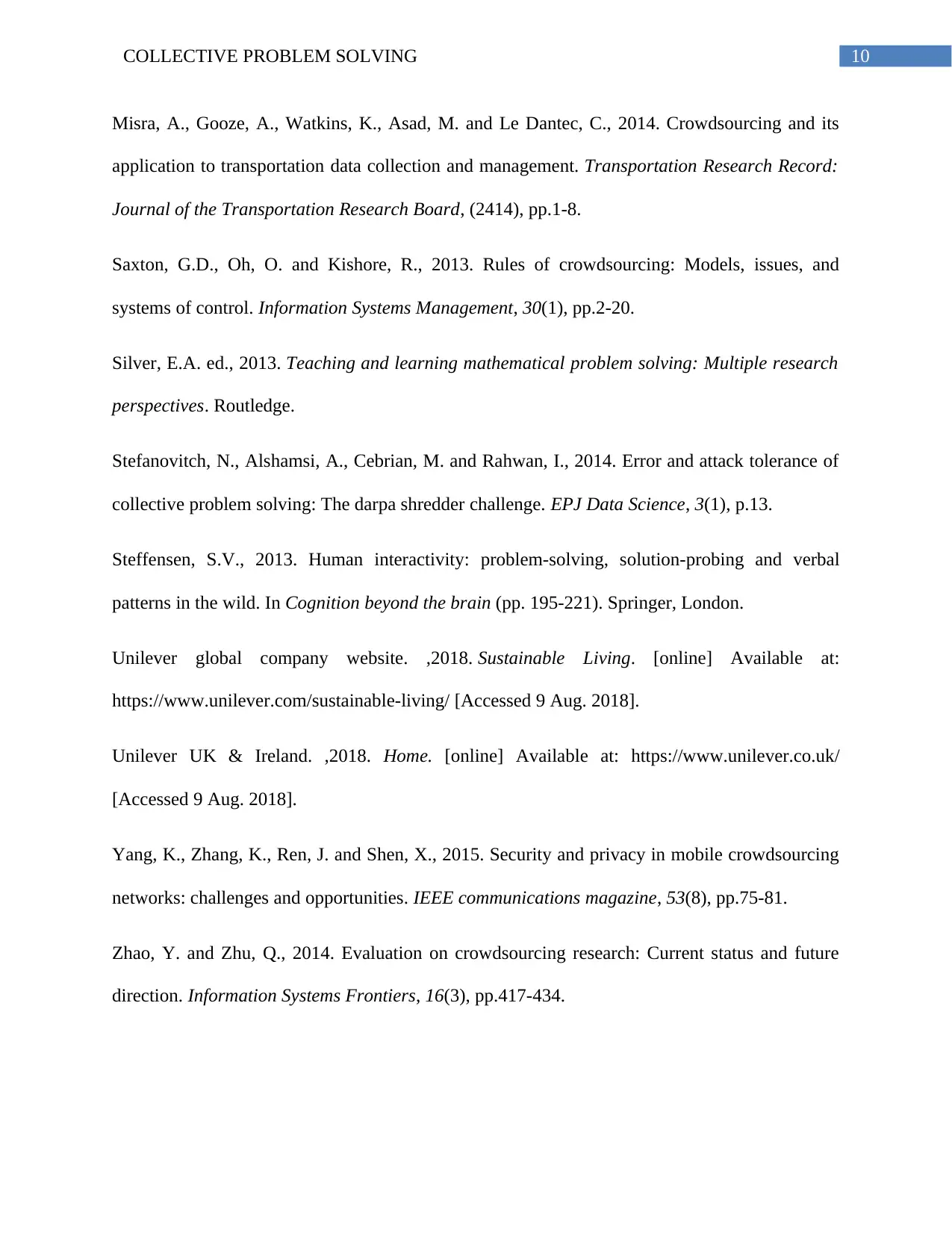
10COLLECTIVE PROBLEM SOLVING
Misra, A., Gooze, A., Watkins, K., Asad, M. and Le Dantec, C., 2014. Crowdsourcing and its
application to transportation data collection and management. Transportation Research Record:
Journal of the Transportation Research Board, (2414), pp.1-8.
Saxton, G.D., Oh, O. and Kishore, R., 2013. Rules of crowdsourcing: Models, issues, and
systems of control. Information Systems Management, 30(1), pp.2-20.
Silver, E.A. ed., 2013. Teaching and learning mathematical problem solving: Multiple research
perspectives. Routledge.
Stefanovitch, N., Alshamsi, A., Cebrian, M. and Rahwan, I., 2014. Error and attack tolerance of
collective problem solving: The darpa shredder challenge. EPJ Data Science, 3(1), p.13.
Steffensen, S.V., 2013. Human interactivity: problem-solving, solution-probing and verbal
patterns in the wild. In Cognition beyond the brain (pp. 195-221). Springer, London.
Unilever global company website. ,2018. Sustainable Living. [online] Available at:
https://www.unilever.com/sustainable-living/ [Accessed 9 Aug. 2018].
Unilever UK & Ireland. ,2018. Home. [online] Available at: https://www.unilever.co.uk/
[Accessed 9 Aug. 2018].
Yang, K., Zhang, K., Ren, J. and Shen, X., 2015. Security and privacy in mobile crowdsourcing
networks: challenges and opportunities. IEEE communications magazine, 53(8), pp.75-81.
Zhao, Y. and Zhu, Q., 2014. Evaluation on crowdsourcing research: Current status and future
direction. Information Systems Frontiers, 16(3), pp.417-434.
Misra, A., Gooze, A., Watkins, K., Asad, M. and Le Dantec, C., 2014. Crowdsourcing and its
application to transportation data collection and management. Transportation Research Record:
Journal of the Transportation Research Board, (2414), pp.1-8.
Saxton, G.D., Oh, O. and Kishore, R., 2013. Rules of crowdsourcing: Models, issues, and
systems of control. Information Systems Management, 30(1), pp.2-20.
Silver, E.A. ed., 2013. Teaching and learning mathematical problem solving: Multiple research
perspectives. Routledge.
Stefanovitch, N., Alshamsi, A., Cebrian, M. and Rahwan, I., 2014. Error and attack tolerance of
collective problem solving: The darpa shredder challenge. EPJ Data Science, 3(1), p.13.
Steffensen, S.V., 2013. Human interactivity: problem-solving, solution-probing and verbal
patterns in the wild. In Cognition beyond the brain (pp. 195-221). Springer, London.
Unilever global company website. ,2018. Sustainable Living. [online] Available at:
https://www.unilever.com/sustainable-living/ [Accessed 9 Aug. 2018].
Unilever UK & Ireland. ,2018. Home. [online] Available at: https://www.unilever.co.uk/
[Accessed 9 Aug. 2018].
Yang, K., Zhang, K., Ren, J. and Shen, X., 2015. Security and privacy in mobile crowdsourcing
networks: challenges and opportunities. IEEE communications magazine, 53(8), pp.75-81.
Zhao, Y. and Zhu, Q., 2014. Evaluation on crowdsourcing research: Current status and future
direction. Information Systems Frontiers, 16(3), pp.417-434.
1 out of 11
Related Documents
Your All-in-One AI-Powered Toolkit for Academic Success.
+13062052269
info@desklib.com
Available 24*7 on WhatsApp / Email
![[object Object]](/_next/static/media/star-bottom.7253800d.svg)
Unlock your academic potential
Copyright © 2020–2025 A2Z Services. All Rights Reserved. Developed and managed by ZUCOL.





